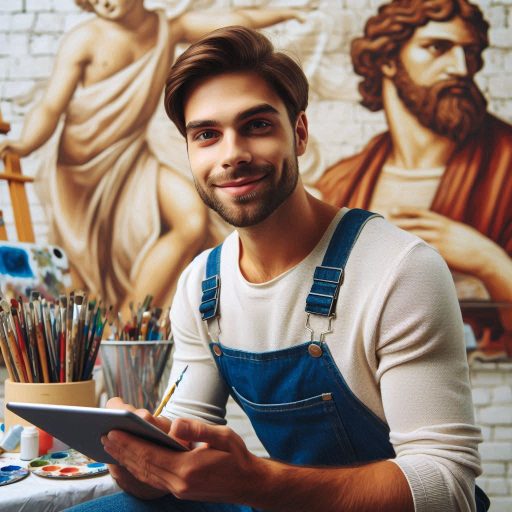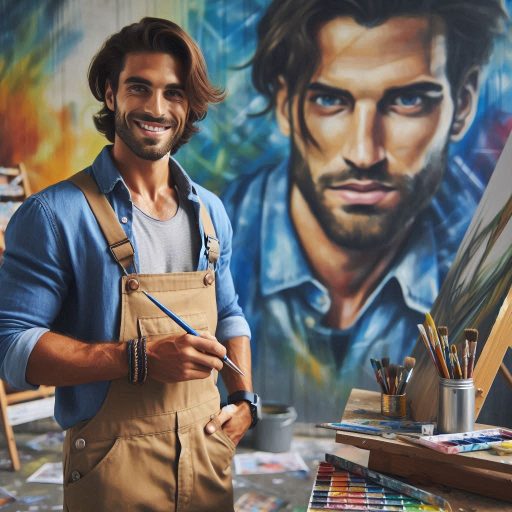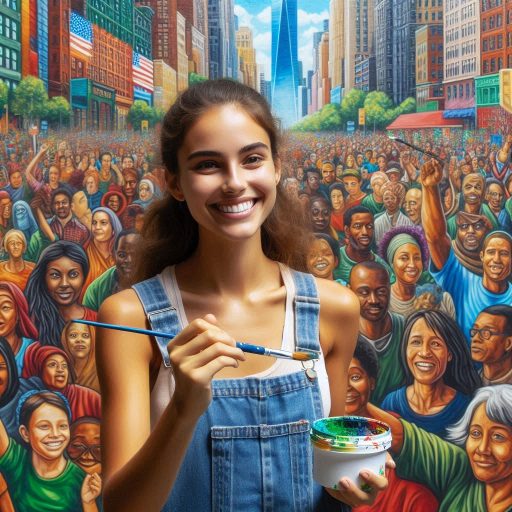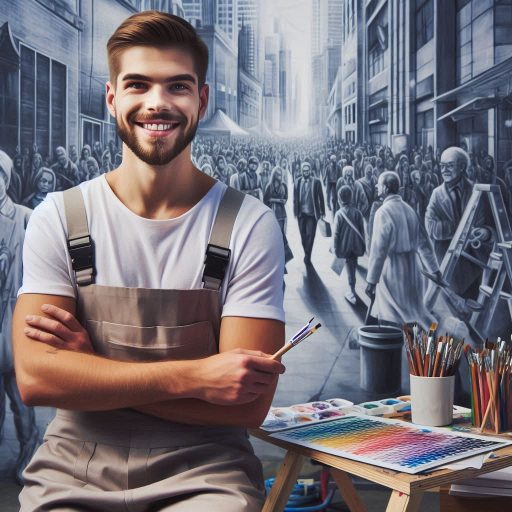Introduction
In the world of art, murals hold a significant place that cannot be overlooked.
These large-scale paintings are not only aesthetically pleasing but also carry a rich history that dates back centuries.
Exploring the evolution of murals allows us to gain a deeper understanding of artistic techniques, cultural influences, and societal values embedded in these works of art.
Brief overview of the topic
Murals have been used as a form of artistic expression since ancient times, often serving as visual narratives that depict historical events, religious themes, and cultural identity.
The art form has undergone various transformations over the years, adapting to the changing trends and technologies of different eras.
Importance of murals in art history
Throughout history, murals have played a vital role in art movements, allowing artists to communicate powerful messages to a broad audience.
These large-scale paintings are not confined to gallery walls but are often found in public spaces, making art accessible to everyone.
Purpose of discussing the history and evolution of murals
By delving into the history and evolution of murals, we can appreciate the diverse styles, techniques, and themes that have shaped this art form.
Understanding the cultural significance of murals helps us recognize their impact on society and how they reflect the values and beliefs of different civilizations.
Definition and Origins of Murals
What a mural is
A mural is a large-scale artwork painted or applied directly onto walls or ceilings.
These vibrant, expressive pieces often depict stories, cultural symbols, or social messages.
Murals transform spaces by adding depth and meaning to the architecture they adorn.
The origins of mural painting
The origins of murals date back thousands of years.
Early examples can be found in prehistoric caves, such as those in Lascaux, France.
These cave paintings, created around 17,000 years ago, are considered some of the earliest forms of human expression.
Ancient civilizations like the Egyptians, Greeks, and Romans also embraced mural painting to narrate myths, honor gods, and document daily life.
How murals have been used throughout history
Throughout history, murals have served various purposes.
In ancient cultures, they were used to communicate religious beliefs, honor rulers, or depict historical events.
During the Renaissance, artists like Michelangelo elevated murals to fine art.
His masterpiece, the Sistine Chapel ceiling, exemplifies how murals can merge art with spirituality.
Transform Your Career Today
Unlock a personalized career strategy that drives real results. Get tailored advice and a roadmap designed just for you.
Start NowMurals became more prominent in public spaces, transforming churches, palaces, and public buildings into showcases of artistic skill and social commentary.
In modern times, murals have evolved into powerful tools for social and political expression.
In the 20th century, artists like Diego Rivera used murals to highlight the struggles of the working class and promote revolutionary ideals.
Street art and graffiti have also emerged as contemporary forms of muralism, allowing artists to reclaim public spaces and challenge societal norms.
From ancient cave walls to modern cityscapes, murals have remained an enduring and dynamic form of artistic expression, shaping both public spaces and culture.
Read: Top Skills Needed for Success in Mural Art and Design
Ancient Murals
Examples of ancient murals from civilizations like Mesopotamia, Egypt, and Greece
In Mesopotamia, the city of Ur featured murals depicting daily life and religious rituals.
Egyptian tombs had intricate murals showcasing scenes of the afterlife and important events.
The Palace of Knossos in Crete had vibrant frescoes depicting bull-leaping and mythical creatures.
Themes and purposes of these ancient murals
The themes of these ancient murals often revolved around religious beliefs, historical events, and daily life.
They served as a way to document important aspects of the respective civilizations and pass down knowledge.
The purpose of these murals was to communicate stories, beliefs, and values to future generations.
Techniques used in creating these ancient murals
Artists in Mesopotamia and Egypt used fresco technique, painting on wet plaster to create durable and detailed images.
Greek artists utilized encaustic painting, which involved mixing pigments with hot wax for vibrant colors and longevity.
These ancient civilizations also used relief carving and mosaic techniques to create intricate and lasting murals.
Renaissance Murals
During the Renaissance period, murals held a significant role in conveying religious and cultural narratives.
Artists utilized this medium to showcase their skills and pay homage to the prevailing themes of the era.
Significance of Murals during the Renaissance Period
- Murals were highly regarded as a form of visual storytelling.
- They adorned the walls of churches, palaces, and public spaces.
- Artists used murals to depict religious, mythological, and historical events.
- Murals served as a way to communicate ideas and beliefs to the masses.
- They played a crucial role in preserving the cultural heritage of the time.
Famous Muralists of the Renaissance
- Michelangelo Buonarroti: Known for his masterpiece on the ceiling of the Sistine Chapel.
- Raphael Sanzio: Created stunning frescoes in the Vatican Palace.
- Sandro Botticelli: Renowned for his intricate murals in the Villa Lemmi.
- Leonardo da Vinci: Contributed to mural art with his work at the Convent of Santa Maria della Grazie.
Religious Themes Dominating Renaissance Mural Art
- Religious subjects were prevalent in most Renaissance mural paintings.
- Themes included biblical stories, saints, and scenes from the life of Christ.
- The Catholic Church commissioned many murals to promote religious teachings.
- Muralists were tasked with creating art that inspired faith and devotion.
- These religious murals served as a form of visual worship and guidance for believers.
Read: How to Price Your Calligraphy and Design Services
Modern and Contemporary Murals
In recent years, murals have undergone a transformation, evolving from traditional styles to more modern and contemporary forms of expression.
This shift reflects changing artistic influences and cultural trends that have shaped the mural art movement.
Transform Your Career Today
Unlock a personalized career strategy that drives real results. Get tailored advice and a roadmap designed just for you.
Start NowEvolution of Murals from Traditional to Modern Styles
Traditional murals were often used to depict historical events, religious themes, or political propaganda.
Artists would painstakingly paint large-scale scenes on walls and ceilings, using rich colors and intricate details to create visually striking compositions.
As the art world evolved, so did the style of murals.
Modern murals began to incorporate abstract forms, bold colors, and experimental techniques.
Artists began to move away from realistic portrayals towards more conceptual and avant-garde approaches.
Impact of Street Art on the Mural Art Movement
One of the biggest influences on contemporary mural art has been the rise of street art.
Graffiti artists have taken mural painting to the streets, using walls, buildings, and public spaces as their canvas.
This urban art form has brought a raw, edgy energy to the traditional mural scene.
Street art has also challenged traditional notions of art-making and ownership, blurring the lines between public and private space.
The influence of street art can be seen in the bold colors, graphic patterns, and social commentary that define many modern murals.
Contemporary Mural Artists and Their Contributions
- Shepard Fairey: Known for his iconic ‘Hope‘ poster featuring Barack Obama, Fairey is a key figure in the contemporary mural scene.
His bold graphic style and politically charged imagery have inspired a new generation of artists. - Banksy: This elusive street artist is famous for his subversive, politically charged murals that challenge societal norms and conventions.
Banksy‘s work has brought international attention to the power of street art as a form of protest and social commentary. - Swoon: Using intricate cut-paper techniques, Swoon creates immersive murals that explore themes of community, identity, and social justice.
Her work often blurs the lines between street art, activism, and traditional mural painting.
Contemporary mural artists reshape public art.
They push boundaries of what defines ‘art.‘
Their work transforms urban landscapes and engages communities.
Each mural tells a unique story and invites interaction.
These artists challenge traditional perspectives and inspire new ideas.
Their creativity redefines public spaces and fosters dialogue.
Their contributions to the genre reflect a new era of creativity and innovation in mural painting.
Read: Glass Art and Design: Essential Resources

Techniques and Materials Used in Mural Painting
Different Techniques Used in Mural Painting
Mural painters commonly use the fresco technique.
They apply pigment to wet plaster. This method creates vibrant, lasting colors.
Transform Your Career Today
Unlock a personalized career strategy that drives real results. Get tailored advice and a roadmap designed just for you.
Start NowArtists work quickly to achieve the desired effect.
Mosaic is another technique, where artists create murals by assembling small pieces of colored glass, stone, or other materials.
Airbrushing is a modern technique that allows artists to create intricate details with the use of an airbrush tool.
Various Materials Artists Use to Create Murals
Some of the materials used in mural painting include acrylic paint, oil paint, spray paint, and enamel.
Artists also use brushes, rollers, and sponges to create different textures and effects in their murals.
In recent years, artists have also started using digital technology to create murals, allowing for more complex designs.
Influence of Technology on the Creation of Murals
Digital tools and software now revolutionize mural creation.
Artists use technology to design murals with precision.
These tools streamline the design process and boost creativity.
Additionally, digital software allows for faster iterations and adjustments.
Some artists now project their designs onto walls using projectors, enabling them to create large-scale murals with precision.
Artists now use virtual and augmented reality to plan murals.
These technologies help visualize designs before painting begins.
They allow artists to see murals on walls virtually.
This process ensures better accuracy and precision in mural planning.
Read: Building a Portfolio for Art and Design Careers
Cultural and Social Significance of Murals
When we think about murals, we often associate them with more than just art.
Throughout history, people have used them to communicate powerfully.
They convey cultural and social messages across different times.
Their influence spans centuries, shaping societies and traditions.
Transform Your Career Today
Unlock a personalized career strategy that drives real results. Get tailored advice and a roadmap designed just for you.
Start NowLet’s delve deeper into the role of murals in society:
How murals have been used to convey cultural and social messages
Murals have a long history of being used as a tool to communicate cultural values and norms.
They often depict scenes from history, folklore, or traditions that are important to a particular culture.
By showcasing these images in public spaces, murals can help preserve and promote cultural heritage.
They also raise awareness of social issues and spark conversations.
These discussions foster important dialogue within the community.
In this way, murals serve as a visual medium for sharing stories and connecting people through shared experiences.
Role of murals in activism and social movements
Murals amplify marginalized voices, giving them a platform to speak.
Activists use murals to highlight important social issues.
These murals visually communicate struggles often ignored by society.
By displaying them publicly, artists ensure their messages reach broad audiences.
Murals engage communities and spark conversations on vital topics.
This art form empowers underrepresented groups to express themselves.
Artists harness murals to demand justice and inspire change.
People use them to protest injustices and demand change.
They also advocate for reforms and push for progress.
Additionally, they commemorate significant historical events and milestones.
Artists often use murals to amplify their message and inspire action within communities.
Through powerful imagery and symbolism, murals have the ability to mobilize people and drive social movements forward.
They act as a visual representation of resistance and solidarity, making a lasting impact on society.
Transform Your Career Today
Unlock a personalized career strategy that drives real results. Get tailored advice and a roadmap designed just for you.
Start NowHow murals can reflect the identity and values of a community
Murals reflect the community, capturing its identity and values.
They showcase local culture and express shared beliefs.
By highlighting important stories, they unite people.
Each mural tells a unique narrative, strengthening community connections.
Local artists often draw inspiration from the surroundings and stories of the people who live in the area.
By incorporating cultural symbols and motifs, murals can convey a sense of belonging and pride.
They serve as a collective expression of a community’s shared history, struggles, and triumphs.
Through murals, neighborhoods can showcase their unique identity and foster a sense of unity among residents.
In general, murals have a profound cultural and social significance that goes beyond their aesthetic appeal.
They are powerful tools for communication, activism, and community-building that have the ability to shape public discourse and inspire positive change.
Preservation and Conservation of Murals
Challenges of preserving and conserving historic murals
- Preserving historic murals poses challenges due to aging and environmental factors.
- Damage from weather, pollution, vandalism, and neglect can threaten the longevity of murals.
- Proper documentation of murals is crucial for understanding their historical and artistic significance.
- Documentation helps in creating records of murals for future restoration and research purposes.
The Importance of Documenting and Restoring Murals
- Restoration helps to maintain the integrity and beauty of murals for future generations.
- Through restoration, the original intent of the artist can be preserved and appreciated.
- Documenting murals helps in identifying the artists, styles, and themes for historical reference.
- Restoration ensures that the cultural heritage and stories depicted in murals are not lost.
Efforts to Protect Murals from Damage and Deterioration
- Communities and organizations collaborate to raise awareness about the importance of mural preservation.
- Training programs educate artists and conservators on proper techniques for mural maintenance.
- Regular inspections and maintenance schedules are implemented to monitor the condition of murals.
- Protective coatings and barriers are applied to murals to prevent damage from graffiti and vandalism.
Discover More: Top Mistakes to Avoid as a New Illustrator
Conclusion
Murals have played a significant role in art history and culture.
They serve as a visual representation of societal values, beliefs, and traditions.
From ancient civilizations to modern street art, murals have evolved as a powerful medium of expression.
Murals are not just decorative pieces but also serve as a form of public art that fosters community identity and pride.
They have the power to transform and beautify urban spaces, creating a sense of connection among residents.
It is important for us to appreciate and support the preservation of murals in our communities.
By valuing these artistic creations, we can ensure that future generations have the opportunity to witness and learn from them.
Next time you see a mural, take a moment to admire the skill and creativity behind it.
Consider the stories and messages it conveys.
Transform Your Career Today
Unlock a personalized career strategy that drives real results. Get tailored advice and a roadmap designed just for you.
Start NowSupport local artists and initiatives that aim to preserve and promote mural art.
Let’s all play a part in preserving this rich art form for the benefit of society.
[E-Books for Sale]
The Big Book of 500 High-Paying Jobs in America: Unlock Your Earning Potential
$19.99 • 500 High-Paying Jobs • 330 pages
Explore 500 high-paying jobs in America and learn how to boost your career, earn more, and achieve success!
See All 500 High-Paying Jobs of this E-Book
1001 Professions Without a Degree: High-Paying American Jobs You Can Start Now
$19.99 • 1001 Professions Without a Degree • 174 pages
Discover 1001 high-paying jobs without a degree! Unlock career tips, skills, and success strategies for just $19.99!




